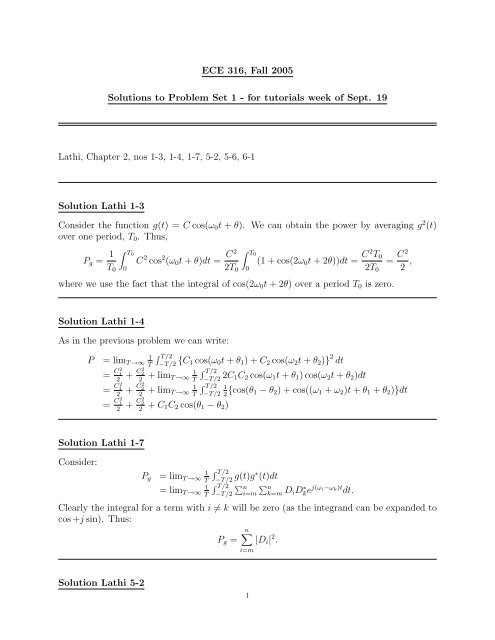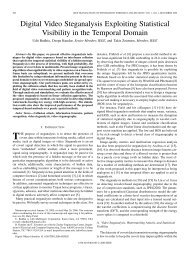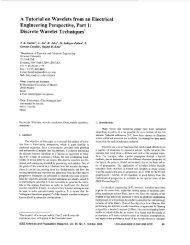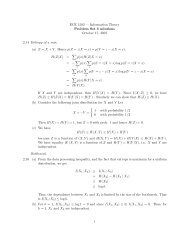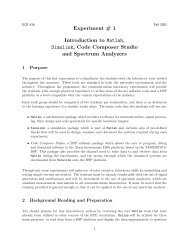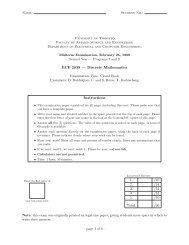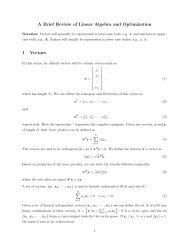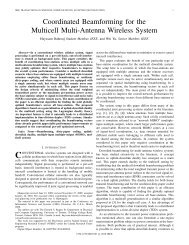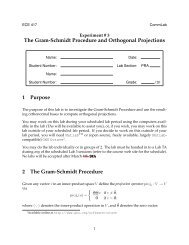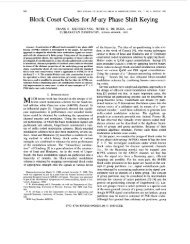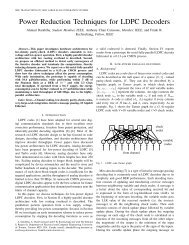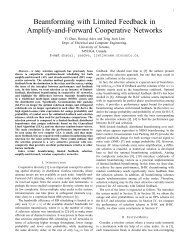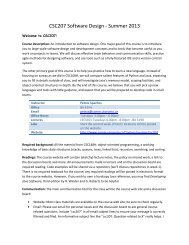ECE 316, Fall 2005 Solutions to Problem Set 1 - for tutorials week of ...
ECE 316, Fall 2005 Solutions to Problem Set 1 - for tutorials week of ...
ECE 316, Fall 2005 Solutions to Problem Set 1 - for tutorials week of ...
You also want an ePaper? Increase the reach of your titles
YUMPU automatically turns print PDFs into web optimized ePapers that Google loves.
<strong>ECE</strong> <strong>316</strong>, <strong>Fall</strong> <strong>2005</strong><br />
<strong>Solutions</strong> <strong>to</strong> <strong>Problem</strong> <strong>Set</strong> 1 - <strong>for</strong> tu<strong>to</strong>rials <strong>week</strong> <strong>of</strong> Sept. 19<br />
Lathi, Chapter 2, nos 1-3, 1-4, 1-7, 5-2, 5-6, 6-1<br />
Solution Lathi 1-3<br />
Consider the function g(t) = C cos(ω 0 t + θ). We can obtain the power by averaging g 2 (t)<br />
over one period, T 0 . Thus,<br />
P g = 1 ∫ T0<br />
C 2 cos 2 (ω 0 t + θ)dt = C2 ∫ T0<br />
(1 + cos(2ω 0 t + 2θ))dt = C2 T 0<br />
T 0 0<br />
2T 0 0<br />
2T 0<br />
where we use the fact that the integral <strong>of</strong> cos(2ω 0 t + 2θ) over a period T 0 is zero.<br />
= C2<br />
2 ,<br />
Solution Lathi 1-4<br />
As in the previous problem we can write:<br />
1 ∫ T/2<br />
P = lim T →∞ T<br />
= C2 1<br />
2<br />
+ C2 2<br />
1<br />
2<br />
+ lim T →∞ T<br />
= C2 1<br />
2<br />
+ C2 2<br />
1<br />
2<br />
+ lim T →∞ T<br />
−T/2 {C 1 cos(ω 0 t + θ 1 ) + C 2 cos(ω 2 t + θ 2 )} 2 dt<br />
∫ T/2<br />
−T/2 2C 1C 2 cos(ω 1 t + θ 1 ) cos(ω 2 t + θ 2 )dt<br />
1<br />
{cos(θ 2 1 − θ 2 ) + cos((ω 1 + ω 2 )t + θ 1 + θ 2 )}dt<br />
∫ T/2<br />
−T/2<br />
= C2 1<br />
2<br />
+ C2 2<br />
2<br />
+ C 1 C 2 cos(θ 1 − θ 2 )<br />
Solution Lathi 1-7<br />
Consider:<br />
1 ∫ T/2<br />
P g = lim T →∞ T<br />
= lim T →∞<br />
1<br />
T<br />
−T/2 g(t)g∗ (t)dt<br />
∫ T/2 ∑ ni=m ∑ nk=m<br />
−T/2<br />
D i Dke ∗ j(ω i−ω k )t dt.<br />
Clearly the integral <strong>for</strong> a term with i ≠ k will be zero (as the integrand can be expanded <strong>to</strong><br />
cos +j sin). Thus:<br />
n∑<br />
P g = |D i | 2 .<br />
i=m<br />
Solution Lathi 5-2<br />
1
From equation 2.31 the constant c is<br />
c = 1 ∫ 1<br />
g(t)x(t)dt =<br />
E x<br />
The energy in the error signal is then<br />
E ɛ =<br />
∫ 1<br />
0<br />
0<br />
∫ 1<br />
0<br />
t · 1dt = 1/2.<br />
(g(t) − 1 2 x(t))2 dt = 1 3 − 1 4 = 1 12 .<br />
Solution Lathi 5-6<br />
(a)<br />
(i) g 1 (t) ∼ (2, −1) (ii) g 2 (t) ∼ (−1, 2) (iii) g 3 (t) ∼ (0, −1)<br />
(iv) g 4 (t) ∼ (1, 2) (v) g 5 (t) ∼ (2, 1) (vi) g 6 (t) ∼ (3, 0).<br />
(b) We can determine if a pair <strong>of</strong> vec<strong>to</strong>rs is orthogonal by checking if the dot product <strong>of</strong><br />
the two vec<strong>to</strong>rs is equal <strong>to</strong> zero. It is easy <strong>to</strong> verify that the following pairs each have a dot<br />
product equal <strong>to</strong> zero: (i) and (iv); (ii) and (v); (iii) and (vi).<br />
Solution Lathi 6-1<br />
The correlation coefficient is given by c = √ 1 ∫ 1<br />
ExE 0 x(t)g(t)dt. Thus<br />
g<br />
c 1 =< x(t), g 1 (t) >= ∫ 1<br />
0 sin(2πt) sin(4πt)dt/√ E x E g1 = 0<br />
c 2 = − ∫ 1<br />
0 sin(2πt) sin(2πt)dt/√ E x E g2 = −1<br />
c 3 = 0<br />
c 4 = 2 ∫ 1/2<br />
0 sin(2πt)/ √ √<br />
2dt/ 1/2 · 1/2 = 2√ 2<br />
. π<br />
1. Determine which <strong>of</strong> the following signals are energy or power signals. For those that<br />
are energy signals, determine their energy. For those that are power signals determine their<br />
power.<br />
Solution<br />
(a) g 1 (t) = e −a|t| , −∞ < t < ∞, a > 0 (b) g 2 (t) = e a|t| , −∞ < t < ∞, a > 0<br />
(c) g 3 (t) = ∑ N<br />
i=1 a i e jnω 0t , −∞ < t < ∞<br />
(a) An energy signal since E g = ∫ ∞<br />
−∞ e−2a|t| dt = 2 ∫ ∞<br />
0 e −2a|t| dt = 1/a.<br />
(b) Neither an energy nor a power signal since the time average <strong>of</strong> the square <strong>of</strong> the signal<br />
goes <strong>to</strong> infinity.<br />
(c) As in a problem above this is a power signal with P g = ∑ N<br />
i=1 |a i | 2 .
2. A collection <strong>of</strong> (complex) functions {φ n (t), n = 0, ±1, ±2 · · · } is called an orthonormal<br />
set on the interval (0, T ) if<br />
∫ T<br />
(a) Show that the set <strong>of</strong> functions<br />
{<br />
√<br />
1/T 0 ,<br />
√<br />
2/T 0 cos(ω 0 t),<br />
0<br />
{<br />
1 m = n<br />
φ n (t)φ ∗ m(t)dt = δ mn<br />
0 otherwise.<br />
√<br />
2/T 0 sin(ω 0 t),<br />
√<br />
√<br />
2/T 0 cos(2ω 0 t), 2/T 0 sin(2ω 0 t), · · · }<br />
are orthonormal over any interval <strong>of</strong> the real line <strong>of</strong><br />
√<br />
length T 0 = 2π/ω 0 .<br />
(b) Show that the set <strong>of</strong> complex exponentials { 1/T 0 e jnω0t , n = 0, ±1, ±2, · · · } are orthonormal<br />
over any interval <strong>of</strong> the real line <strong>of</strong> length T 0 = 2π/ω 0 .<br />
Solution<br />
(a) This derives from the fact that<br />
∫ T0<br />
sin 2 (nω 0 t)dt =<br />
0<br />
∫ T0<br />
0<br />
cos 2 (nω 0 t)dt = T 0 /2<br />
and<br />
∫<br />
2 T0<br />
sin(nω 0 t) sin(mω 0 t)dt = 1 ∫ T0<br />
{cos((n − m)t − cos((n + m)t)}dt = 0 n ≠ m<br />
T 0 0<br />
T 0 0<br />
and similarly <strong>for</strong> other combinations <strong>of</strong> sin’s and cosines.<br />
(b) This follows directly from the previous part since the exponentials can be written in<br />
terms <strong>of</strong> sines and cosines by Euler’s relation.<br />
3. Compute the following complex quantities in polar <strong>for</strong>m:<br />
Solution<br />
(a) (1 + j) 3 (b) ( √ 3 + j 3 )(1 − j) (c) 2−j(6/√ 3)<br />
2+j(6/ √ 3)<br />
(d) j(1 + j)e jπ/6 (e) ejπ/3 −1<br />
1+j √ 3<br />
(a) (1 + j) = √ 2e jπ/4 and so (1 + j) 3 = 2 3/2 e j3π/4 .<br />
(b) j 3 = −j and so ( √ 3+j 3 )(1−j) = 2e −jθ√ 2e −jπ/4 = 2 3/2 e −j(θ+π/4) where θ = arctan −1 1/ √ 3 =<br />
π/6.<br />
(c) 2 − j(6/ √ 3) = 2(1 − j √ 3) = 2e −jπ/3 . Thus, we have (2e −jπ/3 )/(2e jπ/3 ) = e −j2π/3<br />
(d) √ 2e j11π/12<br />
(e) 1 2 ejπ/3<br />
4. Use Euler’s relation (e jθ = cos(θ) + j sin(θ)) <strong>to</strong> show that:<br />
(a) sin(θ) sin(φ) = 1 cos(θ − φ) − 1 cos(θ + φ)<br />
2 2<br />
(b) sin(θ + φ) = sin(θ) cos(φ) + cos(θ) sin(φ)<br />
Solution
(a) Since e jθ e jφ = e j(θ+φ) = cos(θ + φ) + j sin(θ + φ) = (cos(θ) + j sin(θ)) · (cos(φ) + j sin(φ))<br />
the result is obtained by first using θ + φ and then θ − φ and equating real parts.<br />
(b) Similar <strong>to</strong> part (a) except equating complex parts.


